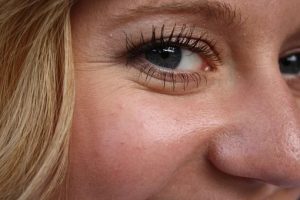Written by Taylor Woosley, Staff Writer. Compared to placebo group, one-month consumption of 180mg C. rabens extract resulted in significant changes in skin wrinkles (p<0.05), brightness (p<0.001), collagen content (p<0.01), and UV spots (p<0.05).
 The skin is the largest human organ and skin aging is the most intuitive form of aging1. Skin is comprised of three different layers including the epidermis, dermis, and hypodermis2. Skin aging is a multifactorial physiological and pathophysiological process affected by genetic, hormonal, metabolic, and environmental factors3. Extrinsic factors such as UV exposure, diet, alcohol use, and smoking lead to changes in the functional characteristics of skin including the breakdown of collagen fibers and decreased structural integrity in the dermis, resulting in wrinkle formation4.
The skin is the largest human organ and skin aging is the most intuitive form of aging1. Skin is comprised of three different layers including the epidermis, dermis, and hypodermis2. Skin aging is a multifactorial physiological and pathophysiological process affected by genetic, hormonal, metabolic, and environmental factors3. Extrinsic factors such as UV exposure, diet, alcohol use, and smoking lead to changes in the functional characteristics of skin including the breakdown of collagen fibers and decreased structural integrity in the dermis, resulting in wrinkle formation4.
The use of plant extracts for skin health, in both cosmetics and supplemental form, has gained popularity over the years due to the polyphenol content which act as anti-aging molecules5. Polyphenolic components such as flavonoids contain anti-oxidative properties which can prevent cell damage and increase the viability of collagen fibrils6. One such herb, Crassocephalum rabens (Asteraceae), possesses anti-inflammatory, anti-oxidative, and anti-hyaluronidase properties7. The primary compound of C. rabens, 1,2-di-O-linolenoyl-3-O-β-galactopyranosyl-sn-glycerol (dLGG), has been shown in research to improve skin wrinkles, moisture, and elasticity8.
Kuan et al. conducted a randomized, parallel, double-blind, placebo-controlled study to evaluate the anti-aging effects of C.rabens extract on healthy skin. Subjects (n=40) were recruited and randomly assigned to the placebo or treatment group. Placebo subjects received 180 mg of a maltodextrin capsule while treatment group consumed a 180mg C.rabens extract capsule, containing around 218.05 mg/mL of dLGG. Both groups consumed the capsules daily for 4 weeks. Skin parameters such as pore size, spots, UV spots, wrinkles, red areas, and texture were measured using the VISIA-CR skin analysis system. Furthermore, skin lightness, hydration content, and skin elasticity were assessed. Skin parameters were recorded at baseline and week 4. Age comparison and measured results of skin parameters within and between groups was analyzed using a paired t-test and an independent t-test, respectively. Significant findings of the study are as follows:
- A noticeable reduction in wrinkles was observed in the treatment group compared to placebo (p<0.05).
- Although both groups exhibited improvements in collagen content, the rabens extract experienced more prominent improvements in collagen synthesis (p<0.01).
- Significant changes in skin brightness and skin hydration was noted in the treatment group compared to placebo (p<0.001).
Overall, 4-week supplementation of C. rabens extract significantly improved skin elasticity, wrinkles, and collagen content in subjects, while also reducing skin wrinkle levels. Further research should continue to explore the anti-aging effects of C.rabens at different dosages and longer study lengths. Study limitations include the large number of female subjects compared to men and the lack of a positive control, varying levels of C. rabens extracts, more in-depth testing parameters, weekly measurements, and follow ups.
Source: Kuan, Chen-Meng, Chia-Hua Liang, Wei-Hsiu Chuang, Ting-Yu Lin, and Pang-Kuei Hsu. “Ameliorating Effect of Crassocephalum rabens (Asteraceae) Extract on Skin Aging: A Randomized, Parallel, Double-Blind, and Placebo-Controlled Study.” Nutrients 14, no. 13 (2022): 2655.
© 2022 by the authors. Licensee MDPI, Basel, Switzerland. This article is an open access article distributed under the terms and conditions of the Creative Commons Attribution (CC BY) license (https:// creativecommons.org/licenses/by/ 4.0/).
Click here to read the full text study.
Posted August 17, 2022.
Taylor Woosley studied biology at Purdue University before becoming a 2016 graduate of Columbia College Chicago with a major in Writing. She currently resides in Glen Ellyn, IL.
References:
- Wang J, Chen Y, He J, Li G, Chen X, Liu H. Anti-Aging Effect of the Stromal Vascular Fraction/Adipose-Derived Stem Cells in a Mouse Model of Skin Aging Induced by UVB Irradiation. Front Surg. 2022;9:950967. doi:10.3389/fsurg.2022.950967
- Lee JH, Park J, Shin DW. The Molecular Mechanism of Polyphenols with Anti-Aging Activity in Aged Human Dermal Fibroblasts. Molecules. Jul 7 2022;27(14)doi:10.3390/molecules27144351
- Ibrahim N, Abbas H, El-Sayed NS, Gad HA. Rosmarinus officinalis L. hexane extract: phytochemical analysis, nanoencapsulation, and in silico, in vitro, and in vivo anti-photoaging potential evaluation. Sci Rep. Jul 30 2022;12(1):13102. doi:10.1038/s41598-022-16592-7
- Im AR, Ji KY, Nam J, et al. Wrinkle reduction using a Sasang constitutional medicine-based topical herbal cream in So-eum subjects: A split-face randomized double-blind placebo-controlled study. Integr Med Res. Mar 2022;11(1):100752. doi:10.1016/j.imr.2021.100752
- Dos Santos Nascimento LB, Gori A, Raffaelli A, Ferrini F, Brunetti C. Phenolic Compounds from Leaves and Flowers of Hibiscus roseus: Potential Skin Cosmetic Applications of an Under-Investigated Species. Plants (Basel). Mar 10 2021;10(3)doi:10.3390/plants10030522
- Vitale S, Colanero S, Placidi M, et al. Phytochemistry and Biological Activity of Medicinal Plants in Wound Healing: An Overview of Current Research. Molecules. Jun 1 2022;27(11)doi:10.3390/molecules27113566
- Hsu P-K, Tsai Y-T, Lin Y-C, Kuan C-M. Assessment of the acute and sub-acute toxicity of the ethanolic extract of the aerial parts of Crassocephalum rabens (Asteraceae) in rats. Toxicology reports. 2022;9:58-63.
- Kuan CM, Liang CH, Chuang WH, Lin TY, Hsu PK. Ameliorating Effect of Crassocephalum rabens (Asteraceae) Extract on Skin Aging: A Randomized, Parallel, Double-Blind, and Placebo-Controlled Study. Nutrients. Jun 27 2022;14(13)doi:10.3390/nu14132655
